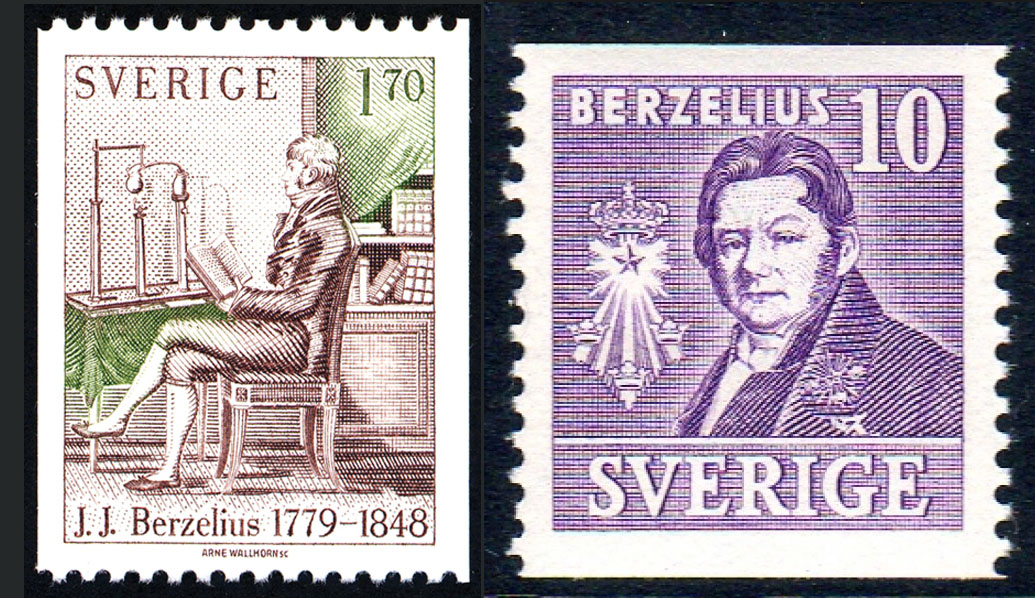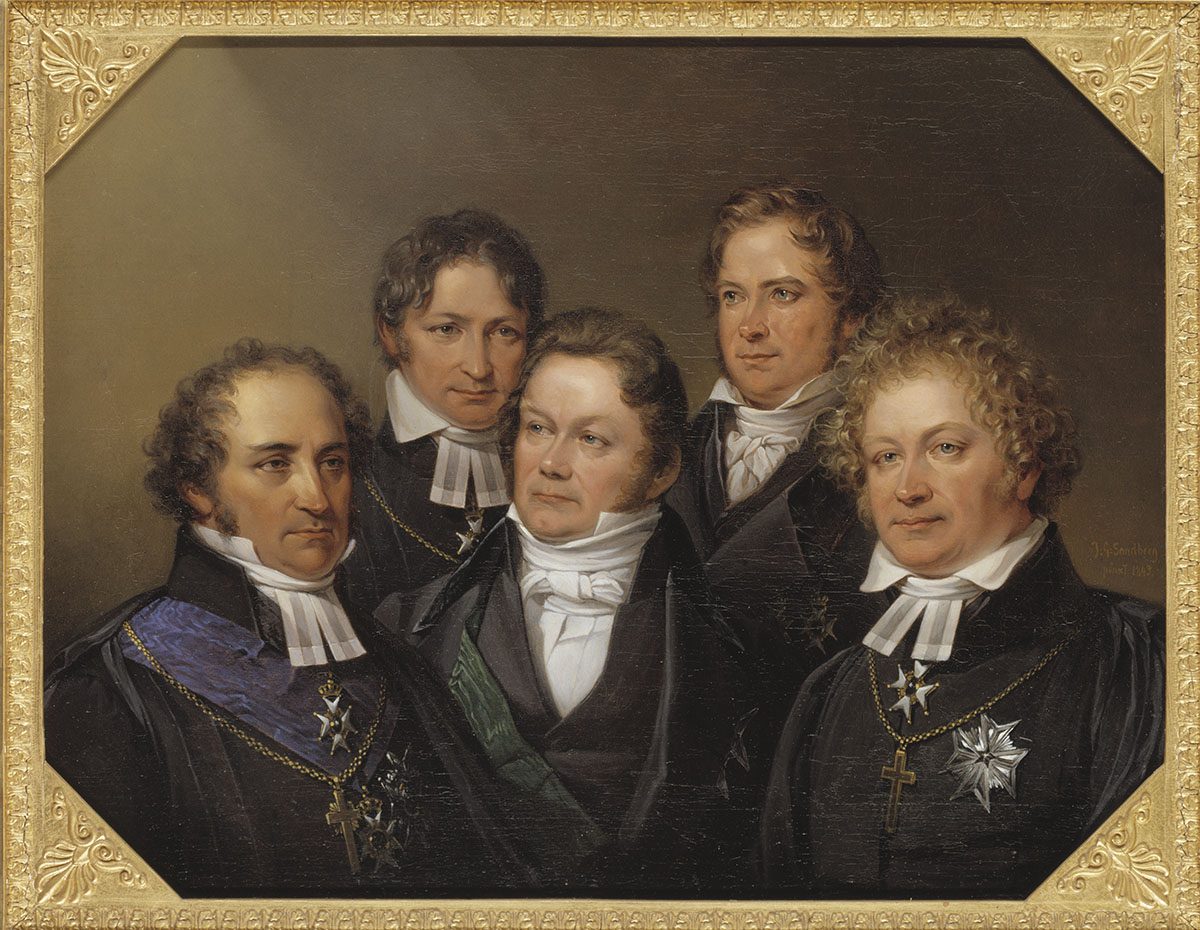From the left: Johan Olof Wallin, Frans Michael Franzén, Jöns Jacob Berzelius, Erik Gustaf Geijer and Esaias Tegnér.
Painting by Johan Gustaf Sandberg, 1843 – Nationalmuseum, Public Domain
TEXT: Frank Wollheim
In addition, he mastered the pen; he left 7000 letters, several books including diaries and an autobiography (1). Based on his humanitarian and literary merits, he became member of the Swedish Academy in 1822. We can follow his life in great detail through many documents of his hand. This story is based on his diaries from two journeys to Europe (2).
The sailing ship Diana had a crew of eight men and only three passengers when it started from the lighthouse Vinga, outside Gothenburg in June of 1812. The ship made 5 knot on the sunny first day. Then it hit a storm and all passengers became seasick. Later, it was approached by a pirate ship and they had to use their 6 canons to fight them off. He was releived when on 29. June he landed in Harwich and could take a coach to London.
Although he had travelled extensively in Sweden this was his first trip outside Scandinavia. At age 33 he was already a famous scientist and professor at the new Karolinska Institute of which he was a co-founder. He had corresponded with scientists in France since the turn of the century. The friend, Claude Louis Berthollet, like Berzelius a physician and chemist, and in contrast to Lavoisier survivor of the French revolution, had invited him to spend time in his home and work at his Société d’Arceuil in Arceuil outside of Paris.
Napoleon’s field marshal Jean Baptiste Bernadotte, had been elected to the Swedish throne in 1810. His friend Berthollet urged Bernadotte to contact Berzelius upon arrival in Sweden. Consequently, Berzelius became a friend of the royalty and recipient of travel funding. In 1812 a planned trip to France was cancelled. Napoleon’s Grand Armé was marching through continental Europe but England ruled “the waves”. Therefore the destination was changed to England.
In London Berzelius writes enthusiastically of a meeting of the Royal Society in an inn close to the Greenwich observatory where he was seated opposite of its president, Sir Joseph Banks and Sir William Herschel and between William Wollaston and Thomas Young. Also present was James Watt, who’s steam engines now were abundant in England. Herschel was originally a musician from Germany, but had become astronomer, and helped by his wife discovered the planet Uranus. Berzelius was invited to his observatory in Slough.
Thomas Young was best known for fundamental discoveries on the nature of light and color vision, but he was also an expert in philosophy, art and Egyptology, making important contributions deciphering the Rosetta stone. William Hyde Wollaston, aged 47, was the secretary of the Royal society. He had discovered the rare earth metals rodium and palladium. Berzelius developed a close friendship with him and spent much time in his elegant laboratory, and was impressed by the simple means with which he demonstrated the presence of uric acid in a small fragment of a friend’s kidney stone. Important discussions dealt with the atom theory of Dalton, which was a basic component of Berzelius’ observations on the distinct proportions of elements in molecules. Wolston also guided him around London. He was more impressed by the laboratories he worked in than by churches or art galleries. But he admired the view from the tower of St Paul’s.
A main purpose of the journey was to meet Sir Humphrey Davy, the most distinguished British chemist at the time. He was famous for his work with laughing gas, and suggested its use for anesthesia some 20 years ahead of Horace Wells in Boston. They had become acquainted through extensive correspondence for some time, and in their groundbreaking electrochemical work both made early use of the Voltaic pile invented in 1799 by the Italian physicist Alessandro Volta.
Berzelius had initiated Davy’s election to the Royal Swedish Academy of Sciences and he brought the insignia from Stockholm. When they finally met Sir Davis responded by nominating Berzelius to the Royal Society. After spending the day in the lab which had the messy look of a real chemistry lab, Berzelius was entertained with an extravagant dinner in Sir Davy’s splendid home, and afterwards taken to the opera. Berzelius was a true opera fan, and made a point of arriving in time for the performance, not like others who came only at the end just in time to enjoy the added on ballet. He was fortunate to hear the Italian Star Angelica Catalani as Susanna in Mozart’s Marriage of Figaro.
Berzelius was duly impressed by the new gaslights on Pall Mall and by how comfortable the springy stage coaches were, although he complained about how expensive it was to use them. In contrast to Sir Humphrey who was wealthy thanks to his wife, Berzelius’ economy was modest. Before returning home he bought several utensils for the lab in Stockholm.
Six years later after “my most productive years”, Berzelius returned to London, again with financial help from his benefactor, now King in Sweden and named Charles XIV John. The king had also knighted him. Berzelius travelled in company with a friend, Gustav Löwenhjelm, the Swedish ambassador to France. This was the start of a 14-month journey including England, France, Switzerland and Germany.
Sir William Wollaston, like Berzelius suffered from gout and gave Berzelius a new medicine containing extract of Colchicum autumnale, naked lady, which however did not help. He was impressed by the quality of the hospitals, schools, invalid veterans’ homes, and prisons. The asylum in Bedlam could release 30 of 100 patients as “cured”. London had gas lights not only in most streets but also indoors.
In the opera he was delighted by listening to the French Star Joséphine Fodor Mainvielle as Zerlina in Mozart’s Don Giovanni. He was now more comfortable speaking English and enjoyed talking to his neighbors in the theater. In his diaries he devotes 5 pages to a description of the new fashion of ladies’, the adaption of which required considerable forbearance, the help of two maids, two chairs with high backrest., and which resulted in bare shoulders and lateral displacement of the breasts.
In Paris, Berzelius was greeted as a celebrity and met the very elite scientists of Europe, such as Gay-Lyssac, Biot, Poisson, Abbé René Just Haüy, the mineralogist, “Father of crystallography”, to whom we also owe introducing the metric system. Berzelius was accommodated at the Löwenhjelm residence close to the Tuileries. In the theater he enjoyed Molière. Soon he became so busy with work that he “had hardly any time to eat breakfast”, visiting laboratories and attending lectures, e.g. by the chemists Gay-Lyssac and Thenard and the physicists Arago and Biot. He was often seated next to the presenter, and blushed when they ex cathedra referred to his publications.
From Jean-Batista Biot he learned the latest regarding polarization of light, discovered in 1808 by Étienne-Louis Malus, who also described the double refraction in crystals in 1810. Jean-Baptiste Biot discovered in 1815 the rotation of polarized light passing through organic material. And on Joseph Louis Gay-Lussac Berzelius wrote that he “I never left him without having learnt something of interest”.
In February 1819 Berzelius moved to Arceuil 3 miles south of Paris and stayed with the Berthollets in their formidable house. Berthollet and Pierre Simon le Laplace had both served in Napoleon’s army in Egypt and Italy. Laplace was professor at the Academy militaire and had examined Napoleon in mathematics during his time as general. The reward was Napoleon’s funding of the Socielé d’Arceil, a private academy with 15 members. One was Napoleon, the others were leaders in science.
Each Thursday a group of younger scientists aged 25-40 joined them from Paris and spent a day with talks, discussions and experimenting. Berzelius acquired a devoted pupil among them, Pierre Louis Dulong. Together they determined the exact atomic weight of hydrogen, nitrogen and carbon, and established the composition of water. Dulong later become the perpetual secretary of the French Academy of Science. While in Paris Berzelius was elected to the same office by the Royal Swedish Academy of Sciences (?). The Thursday work days in Arceuil ended at 5 PM when Comtesse Berthelotte served a gourmet meal. Her skills as a cook, which Berzelius also experienced at the daily breakfast table contributed significantly to his weight gain. Towards the end of his stay Berzelius was joined by two younger Swedish visitors and the three left Paris together, mostly on horseback, explored a number of silent volcanos in the Central Massive, passed through Lyon, Geneva, Zürich and the Alps.
In Germany he visited the universities Tübingen, Erlangen, Dresden and Berlin. He was very critical to the influence of Schelling’s romantic philosophy leading to the denial of Dalton’s atomic therory, and ignoring the discovery of polarized light and disregard of exact science. In Berlin he was disappointed to experience that Angelica Catalani’s voice now had declined. The high notes now sounded sharp. However, he was impressed by the work of Ellard Mitschernich’s work on isomorphic crystallography and was supporting his appointment to a vacant chair at the university in Berlin.

It is of interest that Berzelius did not think highly of the German student unions’ nationalistic attitudes. He predicted that this could eventually lead to bloody violence. He truly had a visionary mind.
Frank Wollheim
References
- Jac Berzelius. Självbiografiska anteckningar. Published by HG Söderbaum. Royal Swedish Academy of Sciences 1901
- Jac Berzelius. Reseanteckningar. Published by HG Söderbaum. Royal Swedish Academy of Science 1903, 1-430.

